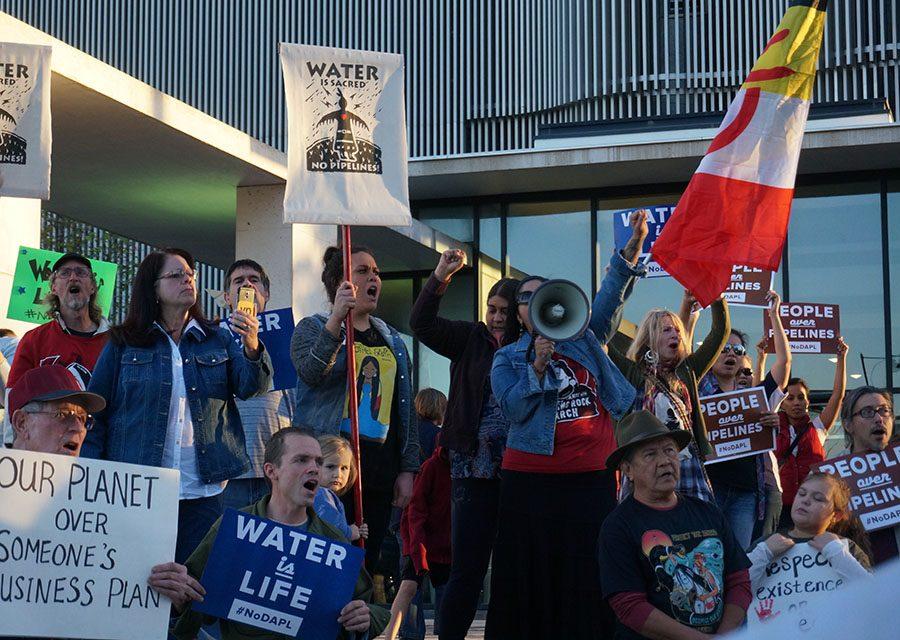Why I’m still standing with Standing Rock
The Army Corps of Engineers’ decision Dec. 4 is an amazing first step, but I’m not sitting down just yet.
Protestors of the Dakota Access Pipeline chant in front of the Richard Bolling Federal Building Nov. 15. During the protest, people used a megaphone to chant, sing songs and pray. photo by Gabby Martinez
December 13, 2016
A drum pounds a steady beat into the air. A bullhorn crackles to life. A couple hundred people of all generations gather, sporting traditional dress, flags, signs and fiery, determined spirits, in order to bring about an important message.
For most of this Kansas City protest, two women handle the bullhorn chanting messages and demands such as, “President Obama!” to which the crowd responds, “Respect our tribes!” More chants include, “People over pipelines!”, “What are we gonna do with that oil?/Keep it in the soil!” and “This is what democracy looks like!” Little children run around, some even participating in the protest by holding signs or taking the podium to lead the chanting. Cars driving home from work often honk their horn to which the crowd hollers and cheers even louder.
This protest is peaceful. Some might even say joyous.
714 miles away, a different protest is taking place. However, this one has not been well-received, to say the least.
Local security retaliates against protestors with mace, followed by tear gas, compression grenades, rubber bullets and beanbag rounds. Hundreds of arrested protesters are corralled into overcrowded cages and denied medical care. To stand for what they believe in, these protesters have faced what concerned United Nations human rights experts are calling inhumane and degrading treatment.
Though scarily different, both demonstrations were held by men, women, and children who are fighting a terrifying new threat – the Dakota Access Pipeline.
Energy Transfer Partners, a natural gas and propane company, proposed the project in 2014. The 1,172 mile long pipeline would transport up to 570,000 barrels of oil per day from oil and natural gas plays, which are essentially gas or oil fields, in North Dakota to Patoka, Ill. According to the ETP, the pipeline is a more direct, cost-effective, safe and environmentally responsible way to transport crude oil.
To sum things up, it sounded environmentally friendly, quick, easy, economical and wonderfully innovative. Until it didn’t.
Concerns started flooding in regarding the safety of the pipeline. Claims launched rapidly, targeting the developer’s plans to move through Standing Rock Reservation. Many people, including members of the reservation, began protesting the pipeline, citing environmental, cultural and religious concerns. The reservation and activists from around the country argued that the pipeline would contaminate the reservation’s drinking water and disturb sacred burial sites.
After months of protesting, it seems like Standing Rock has won finally something. The Army Corps of Engineers announced Dec. 4 that it will not approve an easement for the pipeline to cross under Lake Oahe, which is partially located on Standing Rock Reservation. Jo-Ellen Darcy, the Army’s Assistant Secretary for Civil Works, made the announcement based on a need to explore alternate routes for the Dakota Access Pipeline crossing.
Though the Army’s decision is an amazing step in the right direction, namely for Native American rights, the conversation about the pipeline is not over. I’m not sitting down quite yet. Regardless of the Dec. 4 decision, the pipeline is still going to run across a large part of the United States carrying hundreds of thousands of barrels of oil a day, leading to what could be a detrimental environmental impact.
ETP says that their pipeline is a safe alternative to past methods of transporting oil, and that their new technology will make the pipeline successful. I think that they can say whatever they want. That doesn’t denounce the fact that pipelines suffer hundreds of ruptures and spills every year. In an interview with PBS, CEO of Energy Transfer Partners Kelcy Warren stated that the reason the pipeline would be so safe was because “it’s thick wall pipe, extra thick, by the way, more so than just the normal pipe that we lay.”
Wow. I feel so safe now.
Additionally, it’s possible that the Army Corps of Engineers’ decision could be revoked. ETP is still currently battling in court over whether they can complete their project or not. Also, with President-elect Donald Trump supporting the pipeline, many fear that he will revoke the Army’s decision once in office.
If the pipeline does get the approval it needs, who knows what that will mean for it’s Native American neighbors. According to the ETP website, one of its top priorities is to “protect landowner interests and the local environment.”
Unless I’m missing some key picture here, I don’t really see the whole “protecting” thing happening considering that Native Americans and other protesters at Standing Rock have literally been shot at and caged up like animals.
If you’re still not convinced that this pipeline is a seriously bad idea, click on this map. Find your city, see where your drinking water comes from. Chances are, you drink water from the Missouri River that, for you Kansas Citians, KC Water Services utilizes to produce hundreds of millions of gallons of drinking water each day to more than 170,000 customers via 2,800 miles of water mains. The same Missouri River that hundreds of thousands of people are worried about being contaminated by the Dakota Access Pipeline.
If you’re still not convinced, have fun drinking that oil.












Kate • Dec 15, 2016 at 2:54 am
this is really good…O.o holy cow hon!
Anna Louise Sih • Dec 13, 2016 at 11:56 pm
GABBY THIS IS AMAZING.
Julia Kerrigan • Dec 13, 2016 at 9:19 pm
This was such an informative and illustrative article, with a very impactful closer. Thanks for sharing!
Bridget Graham • Dec 13, 2016 at 8:48 pm
Gabby!! This is such a good article, you made such a convincing argument and I could tell you were speaking from your heart. Amazing photography, amazing writing, keep it going, girl!
Maura Graham • Dec 13, 2016 at 8:48 pm
Wow! Super Impressed with this article! Very well researched and the photos are AMAZING! Thanks for informing STA on such an important topic, this article rocks gabby<3